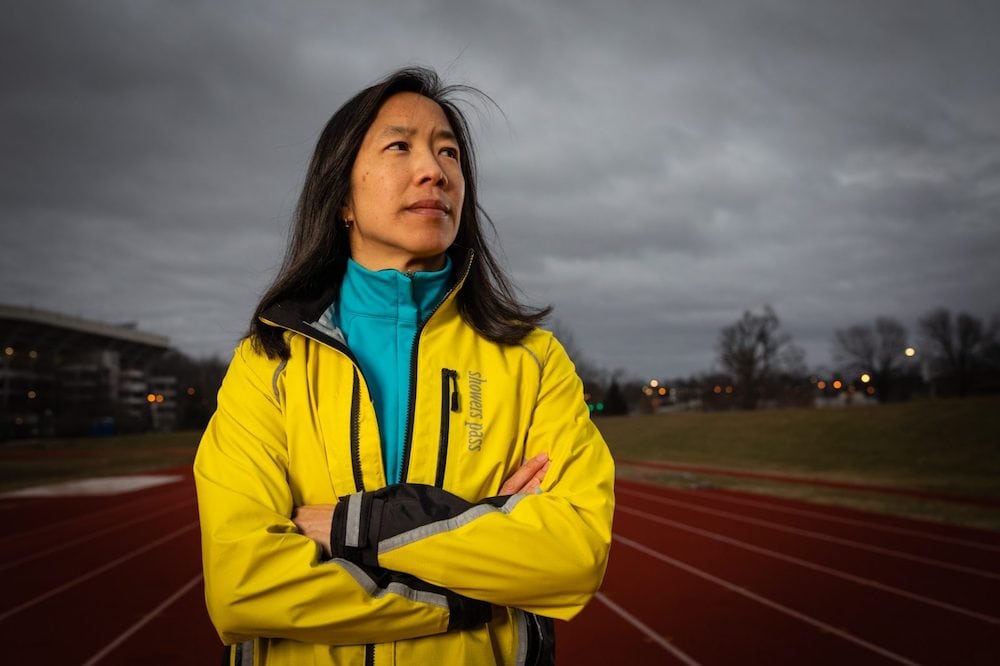I first learned of Dr. Linsey Marr when I read a startling opinion piece that appeared in the New York Times July 30: As “a civil and environmental engineer who studies how viruses and bacteria spread through the air,” she wrote, “I believe that the transmission of SARS-CoV-2 via aerosols matters much more than has been officially acknowledged to date.”
She was not talking about those exhaled droplets that are said to fall to the ground within six feet such that so-called social distancing is a fix. She was talking about the even teensier aerosols that can waft in the air and spread the virus hither and yon.

Reading further about Dr. Marr, a professor at Virginia Tech who is quoted often in public health coverage, I realized that she knew something that the theater community had an urgent need to know.
The theater community (meaning theater management, union leadership, theater practitioners, other arts workers, and audience members alike) is at an awkward impasse. Theaters have been wrestling with issues of safety—in the lobby and auditorium, in rehearsal rooms, backstage, in dressing rooms, and the control booth—while still much in the dark. There simply has not been a lot of science-based guidance that is specific to theater spaces. So I reached out to Dr. Marr.
While very busy, she graciously made time for us to talk. In a warm conversation, I learned that she is herself a theatergoer. She’s never had experience onstage or backstage, but she is, she says, “an appreciator,” with season tickets to the Virginia Tech performing arts series. I also learned that aside from being awesomely knowledgeable across multiple disciplines—the New York Times called her “one of the world’s leading scientists on airborne viruses”—Dr. Marr has that rare gift for making things plain and clear.
John: I feel I should first thank you for your service to the nation’s well-being.
Dr. Marr: Oh, thank you. I appreciate that.
When theaters went dark in mid-March, there were mixed messages from the CDC about whether masks were necessary outside of medical contexts. At the same time, there was a lot of concern about sanitizing and disinfecting of surfaces. Given what science has learned about COVID since, do you think surface transmission has been overemphasized and transmission through the air by aerosols not emphasized enough?
Yes, absolutely. We are now referring to all these surface-cleaning protocols as “hygiene theater.” Time and resources could more effectively be directed toward cleaning the air—which means not spraying things in the air, but better ventilation and filtration.
Looking at the risk of aerosol transmission at close proximity indoors—on a scale from breathing to talking to speaking to singing loudly to shouting to coughing and sneezing—where would you rank laughter?
That’s a good question. A good hearty laugh is probably somewhere between speaking and shouting.
And a mask would mitigate that?
Yes, a good mask should mitigate that.
But without a mask, at close range, there is the same risk from laughing that loud singing would be?
I think so. Or even a cough. I know when I laugh, I’ll sometimes get visible droplets on things, which means there’s even more of the smaller things we can’t see coming out.
Now that theater has migrated from the stage to online, audiences can no longer be a body laughing as one. Everyone is home on Zoom. And laughing in large numbers in close quarters is potentially lethal—which is a terrible thing to think about laughter.
It is.
It’s supposed to be the best medicine.
Right.
Under what circumstances would you tell someone—an actor, for instance—that it would be safe to participate in an indoor live theater production today?
I think if there are few people on stage and it’s a large stage, high ceilings, and if the audience is very sparse.
Under what circumstances would you personally go to a live theater performance indoors?
I don’t think I would.
There are no circumstances today that—?
I would do outdoors. Or I’ve seen on your website there was a drive-in performance. That seems like a great idea.
One theater in DC—the first local company to resume live performances indoors—has installed a new HVAC system with HEPA filter designed to change the air six times an hour.
Okay. That’s what we target.
So, assuming mask wearing and social distancing, you would think that would effectively mitigate aerosol transmission risk?
It depends on how many people there are in that theater.
The theater seating capacity is more than 200, but they’re planning to have no more than 50 people in the entire building at one time, including cast and backstage crew and audience.
If everyone’s masked, I think that’s probably okay. Let me rephrase that. I will say it’s a lower-risk situation.
They’ve done the best job of ventilation that can be done?
They’ve done a very good job of ventilation if it’s reduced capacity. And if people are required to wear masks, then that sounds like excellent risk mitigation.
As audience members arrive, their temperature will be checked. But how reassuring can that routine be given the fact that asymptomatic people can be infectious?
I think it’s hygiene theater. Hopefully, it emphasizes to people that if they do feel any symptoms, they shouldn’t be out in public. But because we have so much asymptomatic transmission going on, temperature checking is of limited utility. It mostly makes people feel good.
What else do you consider hygiene theater?
The idea of the deep cleaning—like all the attention to wiping down nooks and crannies—and certainly any kind of fogging of the air would fall into that category.
It’s performative, not—
—effective.
Because of the administration’s meddling, the authority of the CDC has been compromised, and the U.S. has pulled out of the World Health Organization. How are theaters to know what and whom to believe?
This is the challenge right now.
Along with a group of scientists who were impatient with the CDC’s and WHO’s inattention to aerosol transmission, you developed a comprehensive document titled “FAQs on Protecting Yourself from COVID-19 Aerosol Transmission.” Are there other resources you would point theaters to, to rely on?
I don’t know of any resources specifically for theaters, but I do know that the Harvard Healthy Buildings program has been putting out a lot of really good material at its website, where they have a COVID-19 section. Their focus has been on schools, but there can be some similarities between schools and audiences in terms of the numbers of people you have around. And school is like a performance for the teacher, right?
Since the pandemic began—in the context of widespread denial about the climate crisis—public health experts have been met with partisan suspicion and rebuke. What, if anything, can theater makers do to help restore Americans’ confidence in science?
Oh, that’s a great question. Make scientists seem cool. On TV shows they lionize doctors and first responders and athletes, but nobody’s really lionized scientists.
________
On Friday, September 18, the day this interview took place, the CDC changed the guidance on its website to finally acknowledge that inhalation of aerosols (microscopic droplets or particles) is the main way that COVID-19 is transmitted (as Dr. Linsey Marr and her colleagues had been saying for months). On Monday, September 21, the CDC retracted that acknowledgement, claiming that a draft text had been posted in error. On Monday, October 5, the CDC flipped again and re-acknowledged the risk of COVID-19 transmission by inhalation of the virus in aerosols.
________

Dr. Linsey Marr is the Charles P. Lunsford Professor of Civil and Environmental Engineering at Virginia Tech. She holds a B.S. in Engineering Science from Harvard College and a Ph.D. in Civil and Environmental Engineering from the University of California at Berkeley. She leads the Applied Interdisciplinary Research in Air (AIR2) laboratory and teaches courses on air pollution and environmental engineering. She is a Fellow of the International Society of Indoor Air Quality and Climate and serves on the National Academies of Sciences, Engineering, and Medicine’s Board on Environmental Studies and Toxicology. Dr. Marr’s research group studies the emissions, transformation, transport, and fate of pollutants in indoor and outdoor air. She is especially interested in emerging or nontraditional aerosols such as engineered nano materials and viral aerosols such as viral pathogens and how they can be physically and chemically transformed in the environment. Her research on the airborne transmission of infectious disease has focused on influenza, Ebola virus disease, and Legionnaires’ disease. She collaborates broadly with others to understand how changes at the microscopic to global scale affect public and environmental health. She tweets at @linseymarr.





Dr. Marr’s new research on cloth face coverings shows they help protect both wearers and those nearby (November 23, 2020):
https://vtnews.vt.edu/articles/2020/11/eng-marrmasks-1123.html